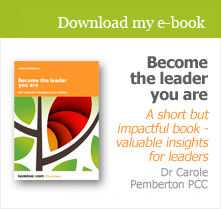The Art of Reflection - part 1

The way I see executive coaching, its key benefits are learning, development and change. There are similarities between executive coaching and leadership, including the fact that not only a coach enables those benefits, but a leader does too if they’re to get the most from their people and to enable, and boost, the delivery of results.
The work of Chris Argyris and Donald Schön, and others, describes the concept of Single Loop Learning, Double Loop Learning and Triple Loop Learning: here too there are important implications for leadership.
Single Loop Learning: Are we doing things right?
Single Loop Learning is about making adjustments to correct a mistake or a problem. It is focused on doing things right, and involves the creation and adoption of new action strategies. This often takes the form of problem-solving, with individuals attempting to improve the systems they operate within, and is characterised by a significant focus on the methods.
The quest for tools and techniques sits within Single Loop Learning: it’s about enlarging the size of the toolbox. Executive coaching can produce results in this context, but they are likely to be limited in scope and over time if this is the only context that’s covered, and the learning and development process to reach them is likely to be thin. Single Loop Learning is necessary, but it is not likely to be adequate on its own.
Double Loop Learning: Are we doing the right things?
Double Loop Learning involves identifying and understanding causality, and then taking action to fix the problem. It’s about doing the right things. Double Loop Learning involves questioning at depth the assumptions, policies and patterns that led to the actions in the first place: the quest is to view and modify them.
Double Loop Learning occurs when people begin to explore and question the underlying assumptions behind their techniques, goals and values in order to understand why they do what they do.
Leaders need to engage in this kind of enquiry in order to raise their own and others’ awareness of the drivers and causalities of what is actually going on within themselves, within others and within their organisations. This helps ensure that their decisions, judgments and relationships are well-founded, and that they can create more psychologically safe workplaces that enable people to give their best, to collaborate and to innovate.
Rather than enlarging the size of the toolbox, it’s about questioning whether the toolbox itself is fit for purpose.
Reflection on why we’re doing what we’re doing is a critical first step, not only for executive coaching to be most effective, but also for leaders to be most effective.
Triple Loop Learning: What are the reasons for our systems, our processes and the results we aspire to?
Triple Loop Learning explores the reasons why we even have our systems and processes, and why we set our desired results in the way we do in the first place. It’s about enquiring into, and trying to ascertain, a deeper understanding of how we (consciously and unconsciously) make decisions that frame our work, and what’s going on inside us, around us, and between the two. It gets to the core of things: our purpose, the impact on us of the systems we exist within, the nature of the complexity we operate within, the norms, the motivations, the fears, our perceived barriers, the blind spots, the patterns and (again) the values that guide us, and their effect on our functioning.
This is the space in which we can enquire into how complexity works in our environments – and the leader needs to constantly engage with complexity, together with its companions, ambiguity, uncertainty, volatility and relentless change.
Triple Loop Learning enquires into what the outcomes are that actually matter, what is important if those outcomes are to be achieved, whether a toolbox is even appropriate or whether some other mechanism is more appropriate, and therefore what shifts need to happen. It’s where executive coaching delivers the richest results.
This kind of raised awareness can ultimately help us review, evaluate and perhaps revise the systems and processes underlying our thinking and behaviour, and the actions we take. It can help us test, experiment, and develop, enact new hypotheses, and indeed readjust the outcomes we’re aiming for.
It’s the territory in which we get to the heart of things – which makes it a critical contributor to both impactful executive coaching and effective leadership. It can enable a developmental process which can be transformational. And it only happens in the presence of reflection.
Development
It’s Double Loop and Triple Loop Learning that lead to development, and to sustainable impact, because change at a level below the surface enables wide-ranging change above the surface. Increasing complexity is a feature of leaders’ working lives as they move up the leadership ladder – and Double and Triple Loop learning are the kinds of learning that lead to development that in turn helps equip leaders to be more agile and adaptive in response to increasing levels of complexity.
This is the stuff of executive coaching: learning, development and change.
Reaping the value of coaching: reflection is necessary – and can be a game changer
My perspective is that coaching is a journey, not a series of tasks. For change to be sustainable, this needs to be a journey with a Triple Loop flavour – and in order to reap its benefits and create the new ways of thinking inherent in Triple Loop Learning, clients need to be interested and engaged in enquiry and exploration – which require reflection.
That reflection happens, of course, in coaching sessions – and crucially, the client needs to make it happen between sessions too, as part of their responsibility for their part in the coaching programme. When it does happen, it can enable new perspectives that in turn enable transformation. It’s a game-changer. When it doesn’t happen, the outcomes of a coaching programme may be relatively modest and may lack dynamism because nothing much changes.
See The Art of Reflection part 2 for more on reflection and engagement in executive coaching.
Photo by Alice Dietrich on Unsplash


